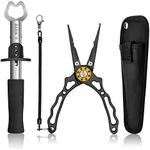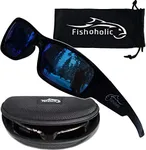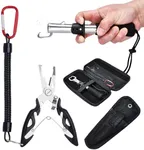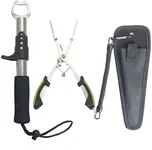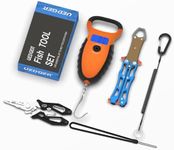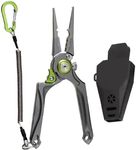Buying Guide for the Best Fishing Gifts
Choosing the perfect fishing gift can be a delightful yet challenging task, especially if you're not an angler yourself. The key is to understand the recipient's fishing habits, preferences, and the type of fishing they enjoy. Whether they are a seasoned pro or a beginner, the right gift can enhance their fishing experience and bring them joy. Here are some key specifications to consider when selecting a fishing gift, along with explanations to help you make an informed decision.Fishing RodA fishing rod is a crucial tool for any angler. It is important because it determines the type of fish that can be caught and the fishing techniques that can be used. Fishing rods come in various lengths, materials, and actions. Shorter rods (under 6 feet) are great for close-quarters fishing and smaller fish, while longer rods (over 7 feet) are better for casting longer distances and larger fish. The material (graphite, fiberglass, or composite) affects the rod's sensitivity and durability. The action (fast, medium, slow) determines how much the rod bends under pressure. Fast action rods are more sensitive and better for quick hook sets, while slow action rods are more flexible and better for casting lighter lures. Consider the recipient's fishing style and target species when choosing a rod.
Fishing ReelA fishing reel is used to retrieve the fishing line and is essential for casting and landing fish. Reels come in different types: spinning, baitcasting, and spincast. Spinning reels are versatile and easy to use, making them ideal for beginners and general fishing. Baitcasting reels offer more control and power, suitable for experienced anglers targeting larger fish. Spincast reels are simple and user-friendly, perfect for children or novice anglers. The reel's gear ratio (speed of line retrieval) and drag system (resistance against the fish) are also important. Higher gear ratios retrieve line faster, while a smooth drag system helps in fighting fish. Choose a reel that matches the rod and the recipient's skill level.
Fishing LineThe fishing line connects the angler to the fish and is critical for successful fishing. Lines come in different materials: monofilament, fluorocarbon, and braided. Monofilament is versatile, stretchy, and easy to handle, making it great for beginners. Fluorocarbon is nearly invisible underwater and has low stretch, ideal for clear water and wary fish. Braided line is extremely strong and has no stretch, perfect for heavy cover and large fish. The line's strength (measured in pounds) should match the target species and fishing conditions. Lighter lines (2-10 lbs) are suitable for small fish and finesse techniques, while heavier lines (20+ lbs) are needed for big fish and tough environments. Consider the recipient's fishing environment and target species when selecting a line.
Tackle BoxA tackle box is used to organize and store fishing gear such as lures, hooks, and tools. It is important because it keeps everything accessible and protected. Tackle boxes come in various sizes and designs, from small, portable boxes to large, multi-compartment systems. Smaller boxes are great for casual anglers or those who fish from shore, while larger boxes are better for boat anglers or those with extensive gear collections. Some tackle boxes have waterproof seals and durable construction for harsh conditions. Consider the recipient's fishing habits and the amount of gear they typically carry when choosing a tackle box.
Fishing LuresFishing lures are artificial baits used to attract fish and are essential for any angler's tackle. Lures come in various types, including crankbaits, spinnerbaits, soft plastics, and jigs. Each type mimics different prey and is used for specific fishing techniques. Crankbaits are great for covering water quickly and targeting active fish. Spinnerbaits create flash and vibration, making them effective in murky water. Soft plastics are versatile and can be rigged in many ways, ideal for finesse fishing. Jigs are excellent for bottom fishing and targeting specific structures. The size, color, and action of the lure should match the target species and fishing conditions. Consider the recipient's preferred fishing style and target fish when selecting lures.
Fishing ApparelFishing apparel includes clothing and accessories designed for comfort and protection while fishing. It is important because it enhances the angler's experience by providing sun protection, warmth, and mobility. Key items include fishing shirts, hats, gloves, and waders. Fishing shirts with UV protection and moisture-wicking properties keep anglers cool and protected from the sun. Hats with wide brims or neck flaps offer additional sun protection. Gloves protect hands from sunburn and provide better grip. Waders are essential for anglers who fish in rivers or streams, keeping them dry and comfortable. Consider the recipient's fishing environment and personal preferences when choosing fishing apparel.


